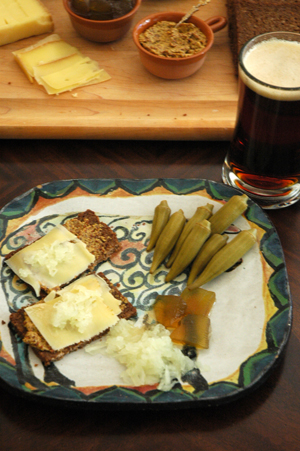

The Cheese
Chiantino is an artisan cheese from the mountainous section of southern Germany known as the Allgäu. This is Germany’s premiere dairy region, with thousands of years of tradition in cheese making craftsmanship. Chiantino is one of the fine washed-rind cheeses that are prevalent in the Alps. Washed with red wine (lightly salted to keep the cheese makers from nipping at it!) imported from Italy, this cheese develops a more distinctive aroma and full-bodied flavor as it matures. It starts out semi-soft, with mild aromas and creamy, buttery flavor. Within a few months, the rind develops its characteristic “earthy” aroma and flavor. Chiantino is made exclusively from pasteurized cows milk from tiny herds that graze the old fashioned way, eating only natural grasses and alpine flora. This diet results in milk unlike that found anywhere else on earth. Chiantino is made in 15-pound wheels, and is typically aged around 4 months
Chiantino is at home as a table cheese, as demonstrated in this pairing, or in cooking as an ingredient in anything from fondue to gratin to polenta— basically anywhere creamy melting is desired.
The Beer
Altbier or “old beer,” refers to the beers produced in Germany and central Europe prior to the development of lagers. While most of Germany was in the throes of pilsner ecstasy in the mid 1800’s, a few towns stuck by their traditional beers. Of those, Düsseldorf, Hanover and Münster continued to make the copper-amber ales prized by the working class. These ales are brewed with a moderate to restrained amount of hops, balanced by hearty malt flavors.
While somewhat similar to the ales of Britain and Belgium, these German versions possess unique qualities that stem from the obsessively clean and precise brewing processes typical of that country. Unlike their British and Belgian counterparts, altbeirs have very little fruitiness. They are also aged for a longer time and at a lower temperature than traditional ales, with a softer, smoother result. This smoothness, combined with a relatively low 5% alcohol content, makes altbier quite drinkable.
There are not many altbiers found in the American market, but two of my favorites are Grolsch amber ale (NOT the stuff in the ubiquitous green flip-top-stoppered bottle!) and domestically, Alaskan Amber out of Juneau. It’s sometimes hard to find, but worth the effort.
The Extras
This pair can be accompanied by any assortment of pickled vegetables. I am particularly fond of pickled okra and watermelon rinds with this cheese. The okra is tangy and crunchy; the watermelon is chewy and sweet-tart. Team this with a real German sourough rye black bread, whole grain mustard and shaved Bermuda onions, and you have a feast fit for a king.
Why it Works
Cheese and beer grew up together on the farms in Europe. Washed-rind cheeses, also referred to as “monastery cheeses” due to the large number developed by the monks in the Middle Ages, are earthy and full-flavored. The monks had to replace meat in their diets from time to time, due to fasting. Meats were usually gamey (at best) and spices were extremely expensive, so the monks looked for inexpensive ways to make their cheeses more like the meats they were accustomed to eating. Hence, washed-rind cheeses were born.
Cheese makers used to wash their cheeses in all sorts of liquids, from the whey separated from the curd, to green (unripe) beer, to the lees of wines to things better left unsaid. The resulting cheeses range from mildly earthy to pungent, and are often beer’s finest partners. Wines lack the one flavor necessary to tame these cheeses—malt. While sweeter wines can deal with the intense flavors of blue cheeses, only beers can accompany these pungent cheeses and hope to hold their own. In this specific pairing, the malt flavors in the altbier stand up to the earthy flavors in the Chiantino, while the hops help cut its smooth, buttery, taste-bud-plugging richness.


